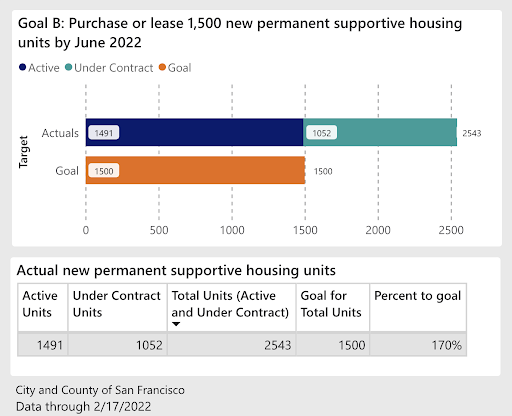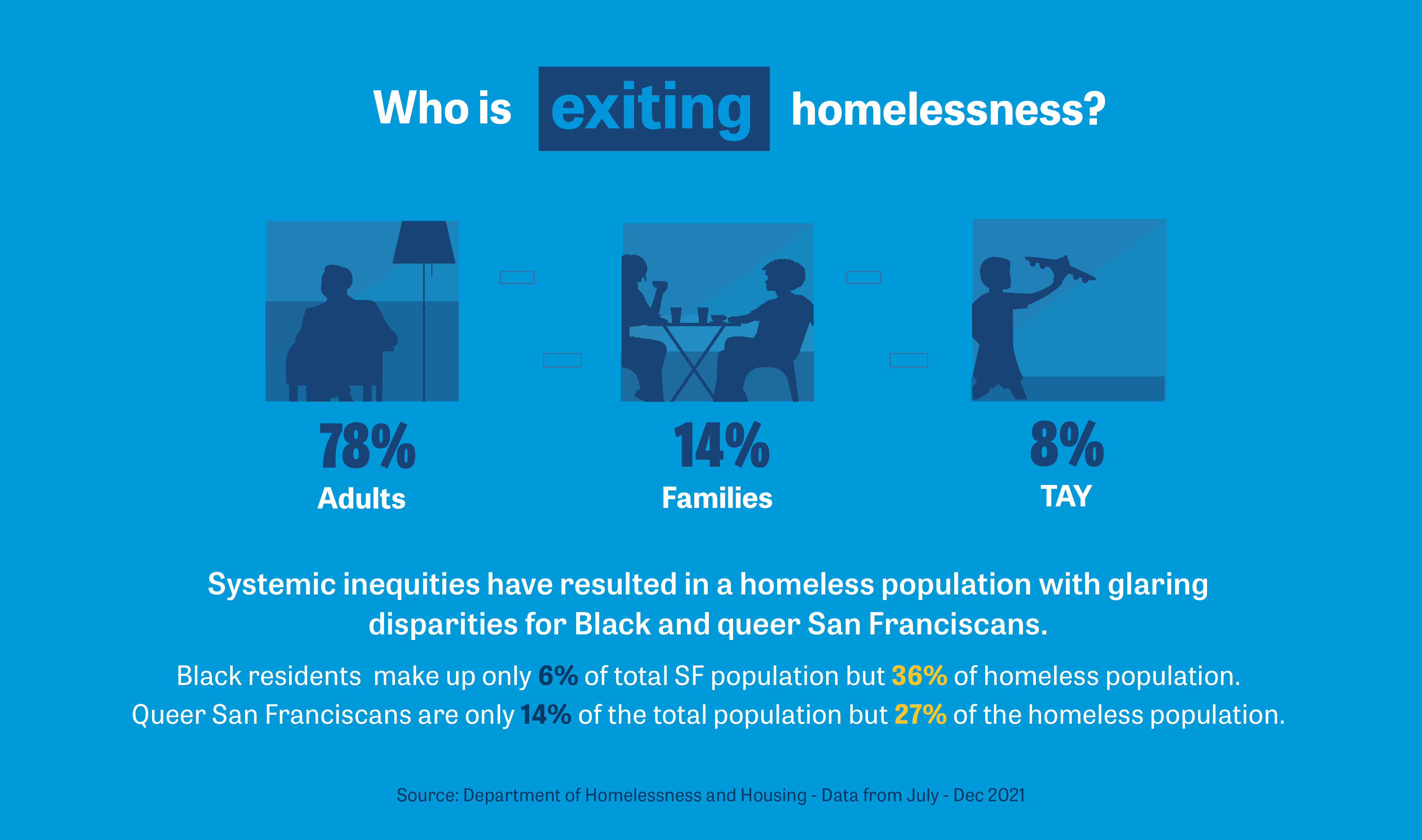From homeless to housed: February Snapshot
Every month, we track the number of people who exited homelessness in San Francisco so we can determine if we are on pace to meet our housing goals for the year. Staying on top of this information helps us ask the important questions – of ourselves and others – to make sure we are doing everything possible to get people off the streets and into homes.

In December, 175 people exited homelessness in San Francisco.
If you’ve been a Snapshot reader for some time, you’ve probably noticed it takes some time for the data to filter through, so we’re always two months behind on the Snapshot numbers (which is why you’ll see we’re reporting on December above).
So for this edition, we’re not only looking at the progress made in December, but also the number of people who exited homelessness over the course of 2021. We also want to call your attention to other important indicators of where the City stands in its effort to reduce homelessness and what to be on the lookout for in the coming months as the City develops its FY23 budget

2021 Overall
The good news is that more people exited chronic homelessness last year than the year before. But although 1,516 new moves home in 2021 is something to celebrate, the distressing news is that we have again fallen short of our housing placement goals. We see the results of our collective failure—people living in places not meant for human habitation, others struggling to get treatment and care, every day. We must back up our calls for greater urgency with action.
And, yet there is reason to be hopeful.
The Homeless Recovery Plan
In July 2020, Mayor Breed announced an ambitious Homelessness Recovery Plan with a goal of creating at least 6,000 placements in housing and shelters for people experiencing homelessness by July 2022.
The data shows that we are well ahead—at 170%— of our goal of creating new permanent supportive housing units.

But with less than six months left, we are only at 54% of our goal to place people into new homes, and 58% toward our housing & shelter goal. Increasing the pace that we move people into new homes and shelters will determine whether we are able to meet our goals by the end of June. We will keep tracking these efforts and reporting them out to you.
Budget Season
As the data reflects, the City has been on a buying spree of sorts, acquiring hotels and apartment buildings for people experiencing homelessness, and in the process creating hundreds of new homes. What we spend money on reflects our values. We applaud the City and the Our City Our Home Committee for prioritizing housing opportunities that permanently end homelessness.
And while the work of securing more permanent exits from homelessness continues, we are now at the beginning budget season, which provides another opportunity to reflect on whether we are spending money on what we value most.
We’re focusing on the City’s budget in this blog, but the state’s budget impacts this work on another level—read more about that in this All In Legislative Update.
In recent weeks, the Department of Homelessness & Supportive Housing (HSH) has shared the outlines of its proposed FY23 budget. Instead of going over the dollars and cents here, we want to focus on what the budget says about where we are as a city confronting homelessness.
HSH plans to prioritize:
- Core Services operations (closing structural funding gaps)
- Racial equity
- Sustainability, particularly for the non-profits that the system depends on most
- Mayor’s Homelessness Recovery Plan (see above)
- Technology solutions (enhance ONE system including shelter bed management functionality)
- HSH Staffing
While these are all important, we want to focus on two of these items: racial equity and sustainability.
Racial Equity
One section we include in each and every Snapshot is the data about disproportionality for Black and LGBTQ+ residents experiencing homelessness.

Sadly, the numbers have not changed since we started the Snapshot; if you are Black or queer, you are much more likely to experience homelessness than if you are not. Meaningful change will require ending the discriminatory structures and practices that contribute to these outcomes, and adopting a laser-like focus, paired with funding, not just on reducing disproportionality but actually empowering communities with the resources and conditions they need to thrive.
This is not just the work of HSH; the whole City needs to come together around it. But, we are heartened to see HSH committing to racial equity.
Sustainability for non-profit partners
Another truth we need to recognize is that the non-profit organizations that make up our homelessness response system are staffed by people who are barely able to make ends meet themselves.
Right now, we are asking staff to take on very taxing work at wages that are unlivable. It leads to burnout, low morale, staff turnover, which compromises the City’s ability to deliver the type of services we know are necessary for a healthy system.
HSH’s proposed budget calls for standardizing PSH case manager pay rates to $28/hour, increasing wages for property management staff, and providing mental health support for front-line staff. HSH is also proposing to get to parity among family, transitional aged youth, and adult systems of care. This is much more than mere accounting. These proposals signal that we see and value the front line staff doing the work of helping people on their journeys from homelessness to housed.
We need you! All In is a campaign built on the people of San Francisco, and here’s how you can show up for our unhoused neighbors:
- Share this blog with three friends/colleagues on Facebook – Twitter to start a meaningful conversation about homelessness in our community.
- The solutions to homelessness start with YOU. Click below to sign the All In Pledge.
Stay up to date with the latest news about homelessness and housing in SF:
- Legislative Update: Money Matters–A Look at The Budget Forecast
- Learning to Listen to The Voices That Matter
- San Francisco group housing measures advance, with modifications
- Office vacancies? Turn them into homes
- Bay Area cities win $5 million to create new housing policies




